
The Banda Islands are a volcanic group of ten small volcanic islands in the Banda Sea, about 140 km (87 mi) south of Seram Island and about 2,000 km (1,243 mi) east of Java, and constitute an administrative district (kecamatan) within the Central Maluku Regency in the Indonesian province of Maluku. The main town and administrative centre is Bandanaira, located on the island of the same name. They rise out of 4-to-6-kilometre deep ocean and have a total land area of approximately 172 square kilometres (66 sq mi). They had a population of 18,544 at the 2010 Census. Until the mid-19th century the Banda Islands were the world's only source of the spices nutmeg and mace, produced from the nutmeg tree. The islands are also popular destinations for scuba diving and snorkeling.
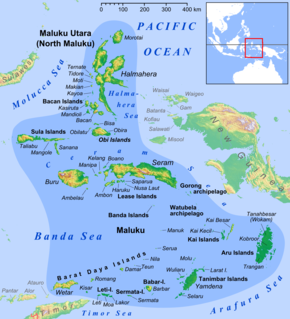
The Maluku Islands or the Moluccas are an archipelago in eastern Indonesia. Tectonically they are located on the Halmahera Plate within the Molucca Sea Collision Zone. Geographically they are located east of Sulawesi, west of New Guinea, and north and east of Timor.

Arnis, also known as Kali or Eskrima/Escrima, is the national martial art of the Philippines. The three are roughly interchangeable umbrella terms for the traditional martial arts of the Philippines, which emphasize weapon-based fighting with sticks, knives, bladed weapons, and various improvised weapons, as well as "open hand" techniques without weapons.

The Aru Islands Regency are a group of about ninety-five low-lying islands in the Maluku province of eastern Indonesia. They also form a regency of Maluku, with a land area of 8,152.42 square kilometres. At the 2011 Census the Regency had a population of 84,138; the latest official estimate was 93,722.
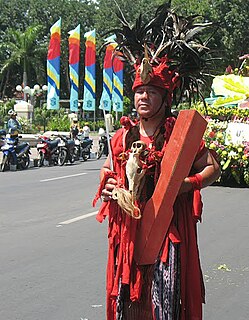
The Minahasans are an ethnic group native to the North Sulawesi province of Indonesia, formerly known as North Celebes. The Minahasa people sometimes refer to themselves as Manado people. Despite the fact that the Minahasan pre-Christian creation myth entails some form of ethnic unification, before the nineteenth century the Minahasa region was in no way unified. Instead, a number of politically independent groups (walak) existed together, often in a permanent state of war.
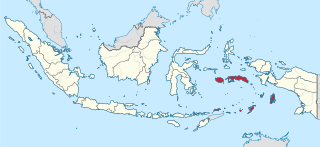
Maluku is a province of Indonesia. It comprises the central and southern regions of the Maluku Islands. The main city and capital of Maluku province is Ambon on the small Ambon Island. The land area is 62,946 km2, and the total population of this province at the 2010 census results amounted to 1,533,506 people; the latest official estimate is 1,768,500. Maluku is located in Eastern Indonesia. It is directly adjacent to North Maluku and West Papua in the north, Central Sulawesi, and Southeast Sulawesi in the west, Banda Sea, East Timor and East Nusa Tenggara in the south and Arafura Sea and Papua in the east.
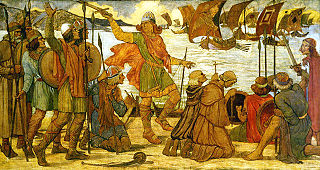
Knowledge about military technology of the Viking Age is based on relatively sparse archaeological finds, pictorial representation, and to some extent on the accounts in the Norse sagas and laws recorded in the 14th century.

South Maluku, officially the Republic of South Maluku, is an unrecognized secessionist republic in the southern Maluku Islands archipelago in Maritime Southeast Asia that claims the islands of Ambon, Buru, and Seram as part of its territory, all of which are currently part of the Indonesian province of Maluku.

Pencak silat is an umbrella term for a class of related Indonesian martial arts. In neighbouring countries the term usually refers to professional competitive silat. It is a full-body fighting form incorporating strikes, grappling and throwing in addition to weaponry. Every part of the body is used and subject to attack. Pencak silat was practiced not only for physical defense but also for psychological ends.

Tobelo is a town and a district on the eastern Indonesian island of Halmahera. It is the capital of the regency (kabupaten) of North Halmahera, part of the province of North Maluku. The city was formalised as the capital of North Halmahera in the district elections held in 2004. It has a population of approximately 33,700. A palm tree lined coastal road connects Tobelo to Galela. The town is predominantly Christian and a Protestant Church has existed in Tobelo since at least 1924.

A war dance is a dance involving mock combat, usually in reference to tribal warrior societies where such dances were performed as a ritual connected with endemic warfare. Martial arts in various cultures can be performed in dance-like settings for various reasons, such as for evoking ferocity in preparation for battle or showing off skill in a more stylized manner. It could also be for celebration of valor and conquest. Many such martial arts incorporate music, especially strong percussive rhythms.

Thomas Matulessy, also known as Kapitan Pattimura or simply Pattimura, was an Ambonese soldier and National Hero of Maluku.

Silat is a collective word for a class of indigenous martial arts from the geo-cultural area of the Indonesian archipelago. It is traditionally practised in Indonesia, Brunei, Malaysia, Singapore, Southern Thailand, Southern Philippines and Southern Vietnam, the indigenous homes to the Malayo-Sumbawan and Javanese speaking peoples. There are hundreds of different styles (aliran) and schools (perguruan) which tend to focus either on strikes, joint manipulation, weaponry, or some combination thereof.
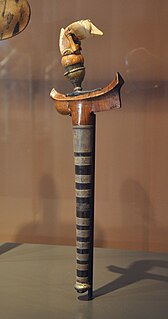
Listed here are the weapons of silat. The most common are the machete, staff, kris, sickle, spear, and kerambit. Because Southeast Asian society was traditionally based around agriculture, many of these weapons were originally farming tools.
Moluccans are the Austronesian-speaking and Papuan-speaking ethnic groups indigenous to the Maluku Islands, also called the Moluccas, which have been part of Indonesia since 1950. As such, "Moluccans" is used as a blanket term for various ethnic and linguistic groups inhabiting the islands.
A Salawaku, is a traditional shield originating from the Maluku Islands, Indonesia. It is also known as Ma Dadatoko, Salwake, Saluwaku or Salawako in Galela, Salewaku-mu in Loloda, Hawau-mu in Madole, Emuli in Buru or O Dadatoko in Tobelo.

Peurise Teumaga or Peurise Lembaga is a shield originating from Aceh, Indonesia. This shield is very identical to the Peurise Awe, except that it is made of brass instead of rattan. The shield was also used by Acehnese warriors during the Aceh War against the Dutch colonials in the 19th century.
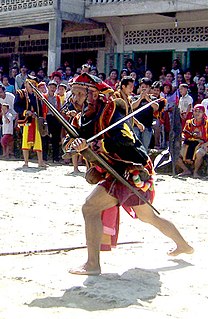
Indonesian martial arts includes a variety of fighting systems native to or developed in the archipelago of Indonesia, both the age-old traditional arts, and the more recently developed hybrid combatives. In the Indonesian language the term bela-diri is used to mean martial art, and in essence the Indonesian fighting arts are meant as one's defence against perceived threat and assault. Other than physical training, they often include spiritual aspects to cultivate inner strength, inner peace and higher psychological ends.
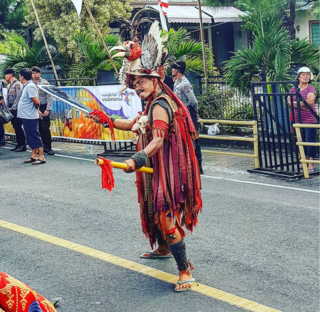
Kabasaran is a traditional Minahasan war dance from North Sulawesi in Indonesia. It is performed by several men clad in red costumes, wielding a sword or spear with a shield. The dancers are called kawasalan, which implies imitating like a pair of fighter cocks. the word kabasaran is derived from kawasalan.
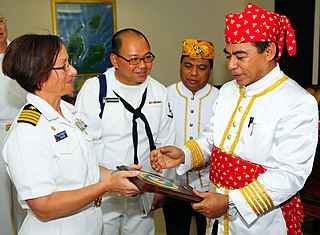
Tobelo people is one of the northern Halmahera peoples living in eastern Indonesia, in the northern part of the Maluku Islands and in the eastern side of North Halmahera Regency.



















